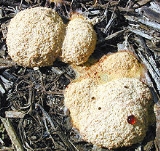
Mycetozoa
Encyclopedia
Mycetozoa is a grouping of slime molds.
, myxogastrid, and protostelid groups.
The mycetozoan groups all fit into the unikont
supergroup Amoebozoa
, whereas most other slime molds fit into various bikont
groups (fonticulids
are opisthokonts).
Slime molds like Physarum polycephalum
are useful for studying cytoplasmic streaming
. They have also been used to study the biochemical events that surround mitosis, since all the nuclei in a medium-sized plasmodium divide in synchrony. It has been observed that they can find their way through mazes by spreading out and choosing the shortest path, an interesting example of information processing without a nervous system
. Myxomycete plasmodia have also been used to study the genetics of asexual cell fusion. The giant size of the plasmodial cells allows for easy evaluation of complete or partial cell fusion.
In 2006, researchers at the University of Southampton
and the University of Kobe
reported that they had built a six-legged robot whose movement was remotely controlled by a Physarum slime mold. The mold directed the robot
into a dark corner most similar to its natural habitat.
Slime molds are sometimes studied in advanced mathematics courses. Slime mold aggregation is a natural process that can be approximated with partial differential equations.
Classification
It can be divided into dictyostelidDictyostelid
The dictyostelids are a group of cellular slime molds, or social amoebae.-Slug behavior:When food is readily available they are individual amoebae, which feed and divide normally...
, myxogastrid, and protostelid groups.
The mycetozoan groups all fit into the unikont
Unikont
Unikonts are members of the Unikonta, a taxonomic group proposed by Thomas Cavalier-Smith.It includes amoebozoa, opisthokonts, and Apusozoa.-Clade:...
supergroup Amoebozoa
Amoebozoa
The Amoebozoa are a major group of amoeboid protozoa, including the majority that move by means ofinternal cytoplasmic flow. Their pseudopodia are characteristically blunt and finger-like,...
, whereas most other slime molds fit into various bikont
Bikont
A Bikont is a eukaryotic cell with two flagella, as its name suggests. It is a division of eukaryotes.-Enzymes:Another shared trait of bikonts is the fusion of two genes into a single unit: the genes for thymidylate synthase and dihydrofolate reductase encode a singleprotein with two...
groups (fonticulids
Fonticula
Fonticula is a cellular slime mold which forms a fruiting body in a volcano shape. As long ago as 1979 it has been known to not have a close relationship with either the Dictyosteliida or the Acrasidae, the two well-established groups of cellular slime molds...
are opisthokonts).
Utility in research
Dictyostelids are used as examples of cellular communication and differentiation, and may provide insights into how multicellular organisms develop.Slime molds like Physarum polycephalum
Physarum polycephalum
Physarum polycephalum belongs to the supergroup Amoebozoa, phylum Mycetozoa, and class Myxogastria. P. polycephalum, often referred to as the “many-headed slime,” is a slime mold that inhabits shady, cool, moist areas, such as decaying leaves and logs...
are useful for studying cytoplasmic streaming
Cytoplasmic streaming
Cytoplasmic streaming is the directed flow of cytosol and organelles around large fungal and plant cells. This movement aids in the delivery of nutrients, metabolites, genetic information, and other materials to all parts of the cell...
. They have also been used to study the biochemical events that surround mitosis, since all the nuclei in a medium-sized plasmodium divide in synchrony. It has been observed that they can find their way through mazes by spreading out and choosing the shortest path, an interesting example of information processing without a nervous system
Nervous system
The nervous system is an organ system containing a network of specialized cells called neurons that coordinate the actions of an animal and transmit signals between different parts of its body. In most animals the nervous system consists of two parts, central and peripheral. The central nervous...
. Myxomycete plasmodia have also been used to study the genetics of asexual cell fusion. The giant size of the plasmodial cells allows for easy evaluation of complete or partial cell fusion.
In 2006, researchers at the University of Southampton
University of Southampton
The University of Southampton is a British public university located in the city of Southampton, England, a member of the Russell Group. The origins of the university can be dated back to the founding of the Hartley Institution in 1862 by Henry Robertson Hartley. In 1902, the Institution developed...
and the University of Kobe
Kobe University
Shindai is one of the leading universities in Japan. It can be seen in the several rankings such as shown below.-General Rankings:The university is ranked 10th in 2010 in the ranking "Truly Strong Universities" by Toyo Keizai...
reported that they had built a six-legged robot whose movement was remotely controlled by a Physarum slime mold. The mold directed the robot
Robot
A robot is a mechanical or virtual intelligent agent that can perform tasks automatically or with guidance, typically by remote control. In practice a robot is usually an electro-mechanical machine that is guided by computer and electronic programming. Robots can be autonomous, semi-autonomous or...
into a dark corner most similar to its natural habitat.
Slime molds are sometimes studied in advanced mathematics courses. Slime mold aggregation is a natural process that can be approximated with partial differential equations.
External links
- Slime Molds
- Slime Mold Solves Maze Puzzle from abc.net.au
- Hunting Slime Molds from Smithsonian MagazineSmithsonian (magazine)Smithsonian is the official journal published by the Smithsonian Institution in Washington, D.C. The first issue was published in 1970.-History:...
- dictyBase is an online informatics resource for Dictyostelium, a cellular slime mould.
- nomen.eumycetozoa.com is an online nomenclatural information system of slime moulds (Myxomycetes, Dictyostelids and Protostelids) of the world.
- good photo gallery
- http://www.ucmp.berkeley.edu/protista/slimemolds.html
- Slime Mold Photos Life cycle of Reticularia lycoperdon at MushooMania.com.

